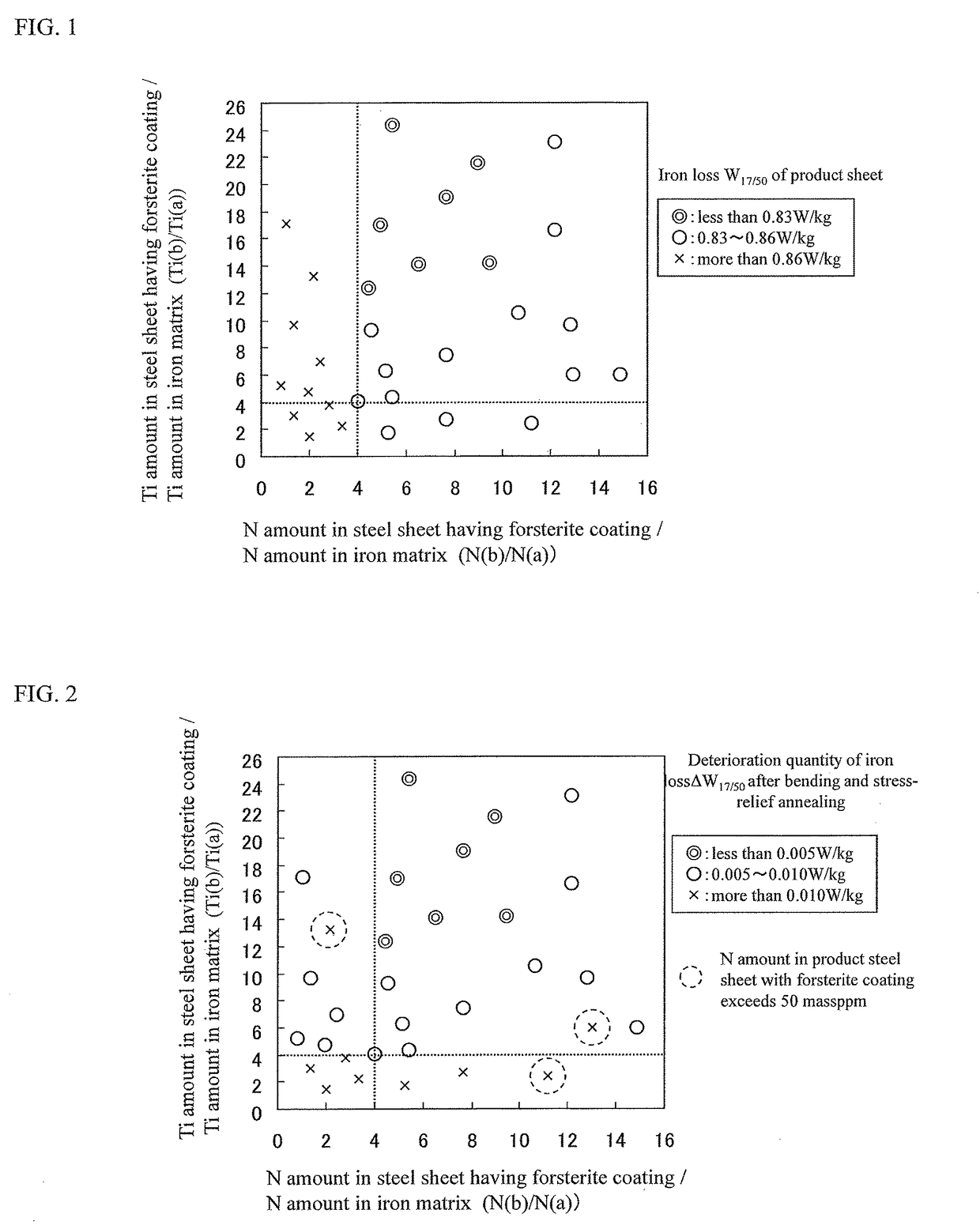Grain-oriented electrical steel sheet and method for producing the same
- Summary
- Abstract
- Description
- Claims
- Application Information
AI Technical Summary
Benefits of technology
Problems solved by technology
Method used
Image
Examples
experiment 1
[0029]A steel slab containing C: 0.032 mass %, Si: 3.22 mass %, Mn: 0.12 mass %, sol. Al: 0.0065 mass %, N: 0.0036 mass %, S: 0.0014 mass % and the remainder being Fe and inevitable impurities is produced by a continuous casting method, reheated to a temperature of 1200° C., and hot rolled to provide a hot rolled sheet having a sheet thickness of 12 mm, which is subjected to a hot-band annealing at 1000° C. for 30 seconds and thereafter cold rolled to form a cold rolled sheet having a thickness of 0.23 mm.
[0030]Next, the cold rolled sheet is subjected to a decarburization annealing in a wet atmosphere of 50 vol % H2—50 vol % N2 having a dew point of 60° C. at 850° C. for 100 seconds. In this regard, an atmosphere in the heating process up to 850° C. is a dry atmosphere of 100 vol % N2 (dew point: −50° C.) from a room temperature to 350° C., a wet atmosphere of 50 vol % H2—50 vol % N2 (dew point: 60° C.) from 350° C. to 750° C., and a dry atmosphere of 100 vol % N2 (dew point: −50° C...
experiment 2
[0034]Next, the steel sheet having a forsterite coating after the flattening annealing obtained in Experiment 1 is subjected to bending simulating winding for an iron core according to “repetitive bending test” described in JIS C2550 in which a first bending is performed by winding the sheet around a rod having a diameter of 50 mmϕ to apply bending of 180° and returning to the original position and then a second bending is performed by applying bending of 180° in the opposite direction and returning to the original position in the same manner, whereby strain is applied to the steel sheet. Thereafter, the steel sheet is subjected to an annealing at 800° C. for 3 hours simulating a stress-relief annealing after the winding, and an iron loss W17 / 50 is measured by a method described in JIS C2550 to determine a difference of the iron loss before and after the bending (deterioration quantity of iron loss).
[0035]The measured results are shown in FIG. 2 as a ratio (Ti(b) / Ti(a)) of Ti amount...
example 1
[0091]A steel slab having a chemical composition comprising C: 0.055 mass %, Si: 3.50 mass %, Mn: 0.07 mass %, sol. Al: 0.0040 mass %, N: 0.0022 mass %, S: 0.0022 mass %, and the remainder being Fe and inevitable impurities is produced by a continuous casting method, reheated to a temperature of 1200° C. and hot rolled to obtain a hot rolled sheet of 2.5 mm in thickness. The hot rolled sheet is subjected to a hot-band annealing at 1020° C. for 30 seconds, cold rolled to a thickness of 1.8 mm, subjected to an intermediate annealing at 1050° C. for 100 seconds and further cold rolled to obtain a cold rolled sheet having a final thickness of 0.23 mm.
[0092]Next, the cold rolled sheet is subjected to a decarburization annealing in a wet atmosphere of 52 vol % H2—48 vol % N2 having a dew point of 60° C. at 850° C. for 100 seconds. In this regard, an atmosphere in the heating from a room temperature up to 850° C. is a dry atmosphere of 100% N2 (dew point: −45° C.).
[0093]Thereafter, the sur...
PUM
| Property | Measurement | Unit |
|---|---|---|
| Temperature | aaaaa | aaaaa |
| Temperature | aaaaa | aaaaa |
| Temperature | aaaaa | aaaaa |
Abstract
Description
Claims
Application Information
 Login to view more
Login to view more - R&D Engineer
- R&D Manager
- IP Professional
- Industry Leading Data Capabilities
- Powerful AI technology
- Patent DNA Extraction
Browse by: Latest US Patents, China's latest patents, Technical Efficacy Thesaurus, Application Domain, Technology Topic.
© 2024 PatSnap. All rights reserved.Legal|Privacy policy|Modern Slavery Act Transparency Statement|Sitemap

